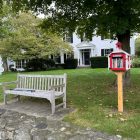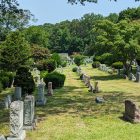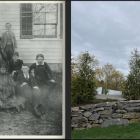There’s free books on Oenoke Ridge. This month, the New Canaan Museum & Historical Society set up a “Little Free Library” next to a bench out front of the 1825 Town House on campus at the top of God’s Acre. “It’s a national organization where you buy the box and you fill it with your books,” NCM&HS Executive Director Nancy Geary told NewCanaanite.com. “And the idea is that people can come and take a book. They can either read it and return it, or they can take it and keep it.”
The organization launched its “library”—a red box on a post that resembles a bird feeder—thanks to the generosity of New Canaan’s Branch family.
The NewCanaanite.com Summer Internship Program is sponsored by Carriage Barn Arts Center. Visitors to New Canaan’s main cemetery soon will be able to tour the hallowed grounds with a mobile app detailing the lives of some of the town’s most noteworthy residents interred there. Using cellular location technology, visitors to Lakeview Cemetery will be able to use the Otocast app for a self-guided tour narrated by a prominent local woman. The app will launch at 4 p.m. Thursday with a special tour, according to Nancy Geary, executive director of the New Canaan Museum & Historical Society. “We hope that people will come out,” Geary said.
The NCM&HS welcomes ArtScapades with a lecture that ties in with their current exhibit: ‘Oh What a Night:A Century of Evening Wear.” ArtScapades will look at the history of fashion in art, and works of art that highlight fashion, ranging from the most basic to the most coveted garments and accoutrements. We will discuss how depictions of clothing in art address many aspects of a culture, from social structures and gender roles to daily activities. ArtScapades will look at works by Jacques-Louis David, Jean-Auguste- Dominque Ingres, James McNeill Whistler, Pierre Auguste Renoir, Winslow Homer, Tamara Lempicka and more.
‘New Canaan Now & Then’ is sponsored by Brown Harris Stevens Realtors Joanne Santulli, Karen Ceraso, Bettina Hegel and Schuyler Morris. The house at 119 Seminary Street (some list it as 115) was once the New Canaan Institute or “Miss Ayres School,” established in 1873 by Harriet Ayres.
According to a 1938 letter from former student W. Benedict, Miss Ayres School supported 25 to 35 students. She established the school because she found the 19th century public school inadequate to prepare students for college. Miss Ayres’ husband, Edward F. Ayres, died in 1900 and her eldest son, Edward, attended Yale where he won the sophomore prize in mathematics in 1886.
One of her students, Percy Raymond, became a Harvard professor emeritus of paleontology and praised Miss Ayres as “the best teacher I have ever encountered.” An Advertiser article dated May 22, 1952 stated “she worshiped at the altar of culture and was responsible for several New Canaan boys who sought higher education and gave a pretty good accounting of themselves later in life.” In 1899 she retired from teaching after 30 years.
She was the first president of the New Canaan Women’s Club—“thirty five brave progressive souls” who had their first meeting at No. 4 Railroad Avenue—present-day Elm Street—at the Reading Room on Sept.
‘New Canaan Now & Then’ is sponsored by Brown Harris Stevens Realtors Joanne Santulli, Karen Ceraso, Bettina Hegel and Schuyler Morris. The Greek Revival Style home at 585 Old Stamford Road known as the Joseph Weber Jr. Homestead has been the residence for some of New Canaan’s earliest families.
The original parcel of land was deeded to Joseph Smith from Seymour Talmadge. Joseph Smith was the son of “Tory Joe” Smith who had lost the family holdings during the Revolution. His new wife, Mary Talmadge, was the daughter of Joseph Talmadge of Flat Ridge. The Smith brothers expanded in this area -James the eldest remained in the family home; Minot had a house on Talmadge Hill; and Sherman built the home in 1840 for his new wife, Mary Elizabeth Hoyt.
The property included a three-story cow barn which bears the architectural markings of a structure built in the 1700s, including wooden pegs/nails and “triple marks” on the beams. At one time, there were four barns on the property as indicated in the 1956 subdivision map.
The New Canaan tax books in 1858 set the value of the home at $1600.



